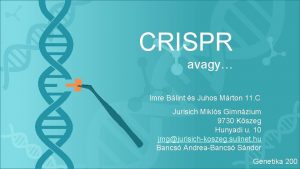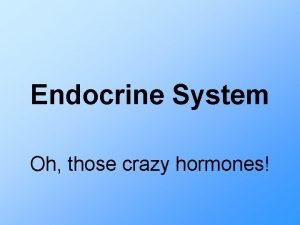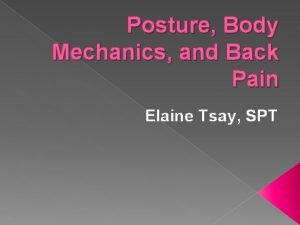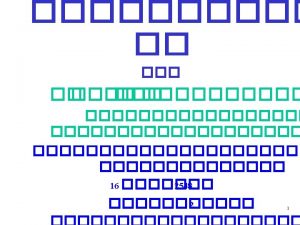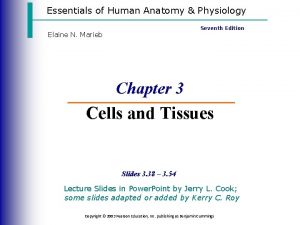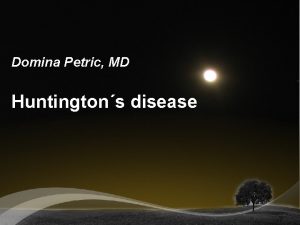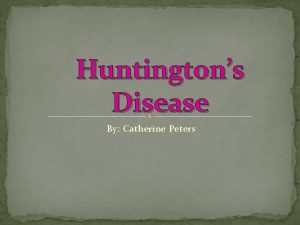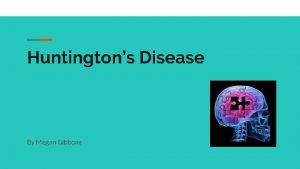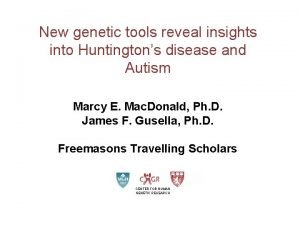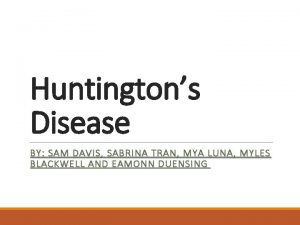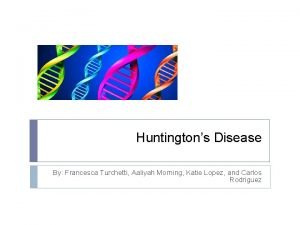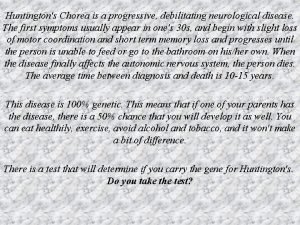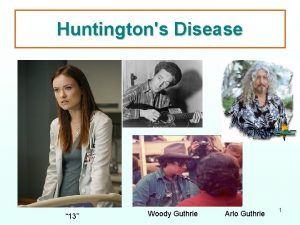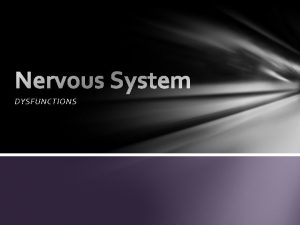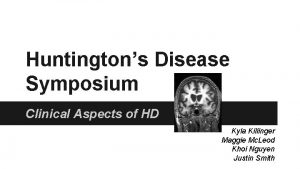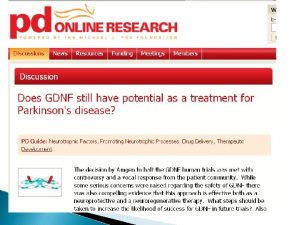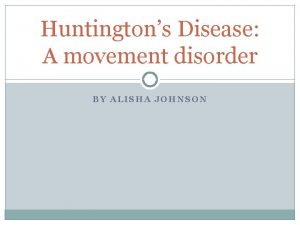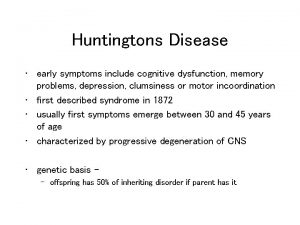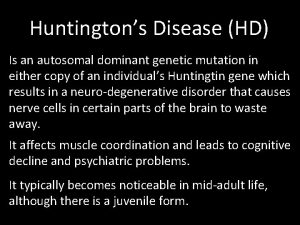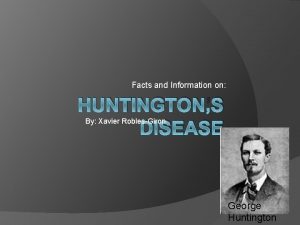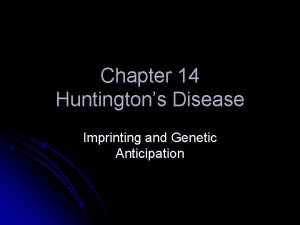Huntingtons Disease Josiah Mc Farland Mattina Girardot Elaine







































- Slides: 39

Huntington’s Disease Josiah Mc. Farland, Mattina Girardot, Elaine Platt

Huntington’s Disease Treatments and Therapies No treatments, medications, or therapies can cure HD or alter the course of the disease The disease cannot be stopped or slowed down at this point, only maintained Drugs and effective therapies have been utilized to lessen the symptoms of movement and psychiatric disorders Compelling need to discover new treatments for motor disability in HD, particularly for non-choreic motor symptoms.

Current Treatments Drugs Specialists Physical Therapists Neurologists Psychiatrists Medical Geneticists Therapies Physical Therapy Speech Therapy Counseling

Treatments in the Making Fruit Fly Models Mouse Models Gene Silencing RNA Interference Stem Cell

Medications for Movement Disorders Tetrabenazine (Xenazine) – most common and first drug approved by the FDA to treat a Huntington’s Disease symptom Levetiracetam (Keppra) and Clonazepam - very similar drugs mainly used to treat epilepsy but also are effective in reducing the chorea associated with HD Antipsychotic Drugs – have side effects of suppressing movement Haloperidol (Haldol) Chlorpromazine

Tetrabenazine Suppresses involuntary jerking and writhing movements associated with chorea Does not treat any other symptoms caused by HD Reduces the amount of certain chemicals in the brain that help control body movement Considered a dopamine depletor Inhibits the vesicular monoamine transporter 2 (VMAT 2). VMAT 2 is responsible for regulating how much of a neurotransmitter is released across the synapse in a neuron. Tetrabenazine prevents these neurotransmitters from binding to the receptors.

Tetrabenazine Clinical Trial Design: Randomized, double-blind, placebo-controlled study over a 12 week period with 84 HD patients Sponsor: Ovation Pharmaceuticals Results: Tetrabenazine reduced chorea symptoms in more than two thirds of patients. Patients who received the medication were six times likely to be considered improved by their doctors. Side Effects: sleepiness, depression, anxiety, agitation, and nausea. One suicide occurred during the study.

Levetiracetam Clinical trial was held to evaluate the preliminary efficacy of levetiracetam in reducing chorea in HD patients Primary endpoint measure was the Unified Huntington’s Disease Rating Scale (UHDRS) chorea sub score Mean UHDRS chorea scores decreased from 12. 6 +/- 3. 0 at baseline to 6. 7 +/at endpoint Results concluded that levetiracetam may be efficacious in reducing chorea in HD patients

Haloperidol Treating schizophrenia and acute psychosis, even the outbursts involved with Tourette’s Syndrome Has some effect of the psychological disorders of HD Think more clearly, have less anxiety, and take part in everyday life. Primarily used for treatment of chorea. Depends on the patient. Some see in increase in involuntary movements, while occasionally there is a side effect of suppressing movement.

Medications for Psychiatric Disorders Antidepressants – may also help treat the obsessive compulsive disorder found in some patients Celexa Zoloft Prozac Antipsychotic Drugs – may suppress violent outbursts, agitation, and other symptoms of mood disorders. Seroquel Risperdal Zyprexia Mood-Stabilizing Drugs – help prevent the highs and lows associated with bipolar disorder Depacon Epitol

Effects of Medications Drugs that treat some symptoms may result in side effects that worsen other symptoms Each designated drug may effect a patient in a different way then the other, so not every medication is beneficial to a patient Over time, drug tolerance may reduce subject’s reaction to a medication Medication management is necessary over the course of the disease Monitoring of medications that a patient takes to confirm that he or she is complying with a medication regimen, while also ensuring the patient is avoiding potentially dangerous drug interactions and other complications.

HTT Protein The abnormal protein (HTT) found in Huntington’s Disease leads to an unusually large amount of nerve signaling early in the disease process Partially blocking these nerve signals prevents neuron death and loss of motor function in fruit fly models of HD Findings suggest possible new ways of delaying the onset or progression of Huntington’s Disease The HTT gene is located on the short (p) arm of chromosome 4

Fruit Fly Models Fly models with the full-length abnormal HTT protein showed a progressive loss of neurons and had shorter lifespans HTT protein triggered a high transmission of nerve signals between neurons Flies were developed with the HTT protein and a partial loss of the calcium channel genes or other genes needed for normal synaptic function Absence of channels reduced synaptic function which counterbalanced the excessive amount of nerve signals caused by the abnormal HTT protein As a result, the flies did not develop neuron loss or movement problems

Fruit Fly to Human Reducing the abnormal nerve signal activity in people with the HTT gene mutation might delay the onset of HD or slow the progression Drugs that reduce nerve signaling are now being put into trial Although Fruit Fly models may correlate to human patients affected with HD, this method is unlikely to cure Huntington’s Disease

Specialists involved in HD care Physical Therapists Speech Language Pathologists Neurologists Psychiatrists Primary Care Providers Medical Geneticists Goals of these specialists: slow the symptoms and help the person function for as long as possible.

Physical Therapy Treatment of physical disease, injury or disability Therapeutic Functional Exercises Training Massage Hydrotherapy Heat Treatment Goal: Maintain and support quality of life

HD’s side of Physical Therapy Similar to Parkinson’s Disease, Muscular Dystrophy, Ataxia, Atypical Parkinson’s Disease, Tourette’s/Tics, and Dystonia HD Symptoms: progressive movement disorders, cognitive deficits, and behavioral changes (all affect daily living) Goals: Enhance fitness, wellness and strength Maintain respiratory capacity Prescribe and fit assistive devices Stabilize gait and balance Educate and support caregivers (home exercise programs)

Stages of PT Early Stage Mid Stage Protect the patient Improve fitness Keep mobile Promote Comfort Strengthening Prevent falls Balance Maintain function & quality of life Gait Alter the patient’s environment Core stability – Maintain respiratory system! – Posture Exercise program Promote relaxation strategies Safety with ambulation Establish a routine Reinforce awareness Caregiver support Functional training Respite Care Home program Transfers Gym program Caregiver training Less time, more frequency Equipment limit fatigue Late Stage

Results Main issues found: Insufficient use of routine physical therapy–related outcome measures at different stages of HD Underutilization of physical therapy services in managing HD (particularly in the early stages the management of falls and mobility deficit progression is a key treatment aim for people with HD. Little data out there about physical therapy approaches to HD.

Speech Pathology In later stages, used to preserve independence in communication and swallowing. May involve alternate communication devices and techniques Includes educating family and friends about communication techniques Goal: Develop strategies for compensating for the communication, swallowing and cognitive issues that arise from the disease

Counseling Physical therapy and speech therapy can help with depression High rate of depression and suicide in HD patients Includes talk therapy to help address behavioral problems coping strategies expectations of disease progression effective communication among family members. Goal: balance the mental struggle of Huntington’s Disease

Non-Traditional Therapies Technology Gaming systems Memory games Visual Tracking Music Art

Mouse models for HD • Mice and humans have the Huntington gene • Mice version is 81% similar to humans but contains less CAG repeats • Three main kinds: knockout, transgenic, and knock in

Knockout model Gene coding for Huntington has been removed so DNA is not transcribed Since no Huntington gene is present, the organisms die during embryogenesis Indicated HD is a “gain of function” disease

Transgenic model Human Huntington gene is inserted into nuclei of model organism Location of gene insertion is not controlled Results in both of the mouse’s copies and the mutated human copy to be expressed Since mutated human gene is not regulated by mouse gene, overexpression of Huntington protein Leads to more obvious disease phenotype.

Knock-in model Whole or part of mutated human HD gene replaces the entire mouse Huntington gene. Most true model HD gene is in appropriate location and is regulated by promoter. Allows for homozygous and heterozygous models

HD gene Caused by a mutation on chromosome 4 Often only on one allele (heterozygous). Results in a larger version of the htt protein causing clumping.

Silencing genes Two methods: ASOs and RNAi


RNAi (RNA interference) The goal is to destroy the m. RNA coding for the mutated HTT Long, double stranded RNA is identified by dicer Dicer cuts up the ds. RNA, and RISC picks up the snipets (si. RNA). RISC then splits RNA into single strands and finds matching m. RNA Slicer, another protein, then cuts up the m. RNA Translation is prevented Researches can create si. RNA to match and turn off a specific gene.

Challenges Delivery of si. RNA into the brain Viral vector Spinal fluid (blood brain barrier) Injection directly into the brain Distribution si. RNA do not spread naturally Different molecules (ASOS) may spread easier Side affects Possible interference with other genes or molecules

ASOs (antisense oligonucleotides) Similar to RNAi Small, single stranded DNA that binds to m. RNA and disrupts translation Spread better throughout the brain and last longer

Ionis pharmaceuticals 3 countries (UK, Germany, and Canada ) 36 HD patients Began phase 1 clinical trial using ASOs in October. Use a lumbar puncture to deliver the ASO. So far Phase 1 has been successful.

Stem cells as a model 1. Studying and understanding the disease Patient cell i. PS cell MSN can then be used for drug discoveries, Or as a model to better understand the HD

Stem cells as a treatment 2. Replacing lost MSNs and restoring function. Applies to other neurodegenerative diseases as well

Next steps in stem cell therapy Further information needs to be gathered on: Survival of lab-produced MSNs Their similarity to those in our brain Ability of these MSNs to integrate into the damaged brain Long-term safety

Eradication of the Disease? Genetic Testing options are now available to determine whether a child of a diseased patient has the mutated gene. Since the onset of HD is not until later in life, many people have children without knowing they have the disease There is a possibility of all affected people receiving test results and not having children based on the outcome. This would make passing on the disease impossible.

References Busse, Monica E et al "Physical Therapy Intervention for People With Huntington Disease. " Physical Therapy 88. 7 (2008): 820 -831. Web. 06 April. 2016. De. Franco, Meredith. "Physical Therapy in Huntington's Disease. "Huntington's Disease Society of America. N. p. , n. d. Web. 3 Apr. 2016. "Huntington's Disease. " American Speech-Language-Hearing Association. N. p. , 2016. Web. 06 Apr. 2016. Kantor, Daniel. "Huntington Disease. " Medline Plus. U. S. National Library of Medicine, 1 June 2015. Web. 3 Apr. 2016.

References Zesiewicz TA, Sullivan KL, Hauser, RA, Sanches-Ramos J. 2006. “Open-label pilot study of levetiracetam (Keppra) for the treatment of chorea in Huntington's disease. ” National Center for Biotechnology Information. 21: 11. Romero E, Cha G-H, Verstreken P, Ly CV, Hughes RE, Bellen HJ, Botas J. "Suppression of neurodegeneration and increased neurotransmission caused by expanded full-length huntingtin accumulating in the cytoplasm. " Neuron, January 10, 2008, Volume 57, Issue 1, pp. 27 -40
 Ti ho svegliato
Ti ho svegliato Josiah litch
Josiah litch 2 chronicles 34 children's lesson
2 chronicles 34 children's lesson Is josiah a dwarf
Is josiah a dwarf Reverend josiah strong
Reverend josiah strong Josiah zayner crispr kit
Josiah zayner crispr kit Lessons learned from king josiah
Lessons learned from king josiah Aiyah josiah-faeduwor
Aiyah josiah-faeduwor Josiah yoder
Josiah yoder Marilynn wong
Marilynn wong Augustin louis cauchy
Augustin louis cauchy Communicable disease and non communicable disease
Communicable disease and non communicable disease Elaine alden
Elaine alden Tallest woman
Tallest woman Thames barrier
Thames barrier Elaine tsay
Elaine tsay Donna paxton
Donna paxton Elaine griffiths
Elaine griffiths Graphical excellence
Graphical excellence Elaine monaghan
Elaine monaghan Madeline wants to purchase a larger house
Madeline wants to purchase a larger house Elaine falconer
Elaine falconer Elaine ferneley
Elaine ferneley Elaine allegretti
Elaine allegretti Elaine justice
Elaine justice The consent elaine kaye
The consent elaine kaye Elaine svenonius
Elaine svenonius Elaine wilson cambridge
Elaine wilson cambridge Elaine nevin
Elaine nevin Dr elaine ho bowmanville
Dr elaine ho bowmanville Elaine bannatyne
Elaine bannatyne Dr elaine clark
Dr elaine clark Elaine allegretti barking and dagenham
Elaine allegretti barking and dagenham Laura crichton
Laura crichton Elaine buckley
Elaine buckley Susan elaine rancourt
Susan elaine rancourt Cass safeguarding
Cass safeguarding Kelly hoppen age
Kelly hoppen age Florigelia
Florigelia Duct repair elaine
Duct repair elaine





